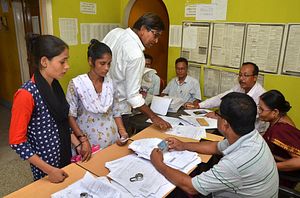Burmese nationals have been crossing the border to India’s northeastern states for the past several decades, driven by a combination of many factors. Now, an affidavit in the country’s Supreme Court in New Delhi claims that many of them have also enrolled as Indian citizens in Assam through fraudulent means.
The affidavit was submitted by an NGO, Sachetan Nagarik Mancha Axom, as an intervener in a case that resulted in the update of the National Register of Citizens (NRC) in Assam after a gap of more than six decades. More than 4 million people were left out of the register in the final draft list published last year. The deadline for the completion of the exercise is July 31.
The 15-page affidavit alleges that more than 8,000 nationals from Myanmar and Bangladesh belonging to the Kuki and Hmar communities have not only settled down in Assam’s hill district of Dima Hasao, but have also enrolled in the register through false claims in legacy data. Among the numerous norms laid down for inclusion in the NRC, an applicant must furnish extensive details about their family, which must match with that of their ancestors.
The affidavit has attached a large number of cyclostyled documents procured from the NRC Secretariat, which allegedly give the names of the illegal migrants, the documents they have submitted for inclusion in the register, along with the 21 digit Application Receipt Number (ARN) issued to them. It had made a case for the reverification of 10 percent of the list in all the 33 districts of Assam ahead of the deadline on July 31.
A government official in Dima Hasao admitted the presence of Hmar and Kuki communities at Jinam Valley for the past many decades. “But there is no information about citizens from the neighboring countries settling in the district and nor have any complaints been lodged so far,” he said.
Migration From Myanmar to India
A policy called the “Free Border Regime” is in vogue along the 1,643 kilometer-long India-Myanmar border, which allows citizens from one country to cross the border and travel up to a distance of 16 km into the other’s territory. However, many citizens from Myanmar, especially from Sagaing division and Chin state, have also taken up jobs and have settled permanently in a few states in India’s northeast like Mizoram, Manipur, and Nagaland. There are also students from Myanmar admitted in schools in these border states of India.
The free movement led to a spurt in criminal activities, which caused the Indian government to come up with proposals to fence the border at Moreh and Noklak. The border fence could not be completed due to opposition from the local population.
A report compiled by Human Rights Law Network on the basis of field investigations in Mizoram – Chins of Myanmar in Mizoram: A Fact Finding Report 2005 – stated that there were “at least 63,000 Chins in Mizoram” with the highest concentration in the border district of Champhai. It also noted the movement of the migrants from Mizoram to other regions.
“Movement of Chins to other Northeastern states is negligible (except those Lushais, Paites and other Chin-Kuki groups who enter on the Manipur side of the border) and within Mizoram to a certain extent. In general, the Chins prefer to stay where they find close ethnic affinities,” said the report, referring to a sudden increase of their population in Champhai following the eviction drive by the Young Mizo Association in some districts of Mizoram.
The Hmar community that inhabits the northern districts of Mizoram and the contiguous regions of Assam also belongs to the Kuki-Chin-Mizo ethnic stock, whose language is also similar to the Chin. A leader of a former rebel group called Dima Halam Daogah (DHD), which was active in Dima Hasao years ago, did not rule out the possibility of Chin migrants settling down at Jinam Valley in the district.
Fraudulent Entries in the NRC
Many cases of fake submissions by illegal migrants have been unearthed since the process to compile the list of citizens began in Assam four years ago. Concerned over the development, many interveners, including the government of Assam, have submitted affidavits in the Supreme Court with pleas for reverification of the list. Last year, the apex court instructed the NRC Secretariat to recheck 10 percent of the people in all the districts of the state who have been included in the list.
“It is not known if the Secretariat has actually done the reverification as ordered by the Supreme Court. We have submitted a huge quantity of documents as evidence to Supreme Court proving how illegal migrants have got into the list using a variety of tactics,” said Chandan Bhattacharjee, president of Sachetan Nagarik Mancha Axom.
The NRC Secretariat has not yet disclosed the breakdown by district of the 4 million people who have been excluded from the list so far. Data compiled from different sources by senior journalist Mrinal Talukdar, which have been quoted in many reports, revealed that a total of 14,067 people have been left out of the citizens’ list in Dima Hasao, which cuts across communities like the Assamese Muslims, Bengali-speaking Muslims and Hindus, Nepalis, and tribals (like Dimasa, Hmar, Kuki, Naga, etc). A figure of 4,541 has been cited for tribals in the district whose names were excluded but the breakdown of communities has not been given.
Rajeev Bhattacharyya is a senior journalist in Assam, India.

































